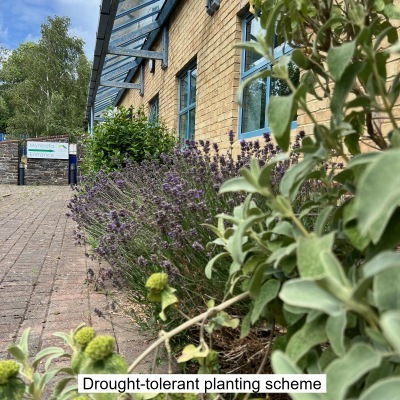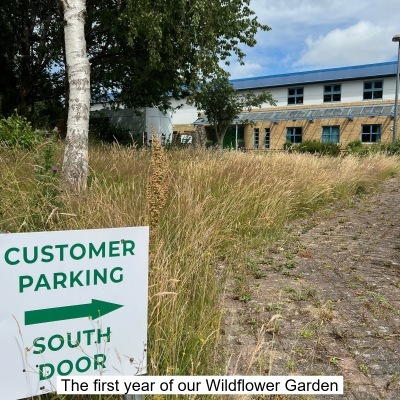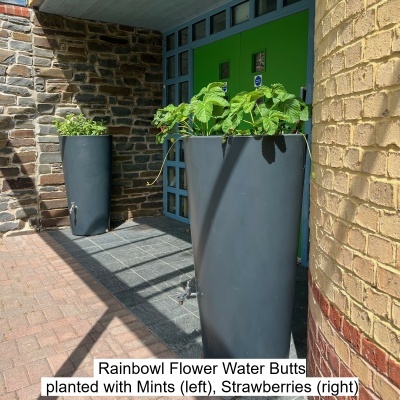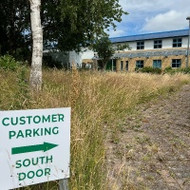Drought in Wales? Hosepipe ban?
Posted by Celtic Sustainables on 4th Jul 2025
Today, we are just one stage away from a hosepipe ban here in our little corner of Wales, and we can hardly believe it! In Cardigan, we haven’t experienced the heatwaves that have affected the rest of the UK, but it has been significantly drier than usual.

Yesterday we received an email from Welsh Water saying that they have escalated Mid and South Ceredigion (where we are located) to level 2 of their 5-level drought plan. If we don’t receive substantial rain soon, we will move to level 3, which will mean a hosepipe ban. Welsh Water is asking us all in this area of Wales to “think about the way we use water and to cut down on waste”. So, we've been considering our options, as no one likes a hosepipe ban.
In our previous shop and warehouse, we utilized rainwater to flush the toilets, and we truly miss that fantastic rainwater harvesting system! We plan to implement a similar system in our new unit later this year—so stay tuned for updates. We will also use the harvested rainwater to test pumps, and if we ever expand to a fleet of vehicles, it would be easy to modify the system for van washdowns.
In the meantime, we are exploring additional ways to reduce our water usage. When we moved into our new unit in Cardigan, there was quite a bit of work that needed to be addressed right away.
Cutting down on water use in the office – actions we have already taken

- Fixed leaky toilets (we had to replace a couple of ballcocks, but most just needed a slight adjustment).
- Repaired the dripping tap in the kitchen
- Reduced the frequency and flow of the automatic flush on the urinals (seriously, it used to sound like someone was filling a bath with the taps opened to the max in there!).
- Unblocked all the gutters (so we can harvest rainwater more effectively).
Fortunately, the flower beds around the office are designed with drought-tolerant perennial plants like lavender, rosemary, phlomis and ivy.
We have decided not to water the grassy area, as we plan to develop a wildflower meadow (more updates on this in later posts). If you do have a lawn, you can keep the grass a bit longer than usual; this helps it become more drought-tolerant and also saves on energy costs since you won’t need to cut the grass as often.
Cutting down on water use in the office – further things we could do:

- Fitting tap aerators: We could fit aerators to the kitchen and bathroom taps. These cost about £5 each (and the time to fit them). They work by reducing the flow of water, but the pressure is maintained. Most people don’t notice the drop in flow because the water “feels” the same therefore they don’t turn the tap on as far to get the amount of water they need to wash your hands etc. Filling the kettle and the sink for washing up takes a bit longer though as there is less water coming out of the tap per minute.
- Save Water for Planting: If we water plants around the office, we can wash cups in a washing-up bowl and use the remaining water for the flower beds. Currently, we wash our cutlery and crockery individually, which doesn’t justify the use of a dishwasher. Using a washing-up bowl not only captures water but also helps us conserve it.
- Further Toilet Optimization: None of our toilets are dual flush (which use less water than older-style flush toilets), but they are low-flow. We won’t be replacing functional toilets unless they break, considering our carbon footprint as well. If our toilets were very old (high-flow units), we could consider installing a water displacement device in the cisterns to reduce the amount of water used per flush. While popular methods in the past included placing a brick in the cistern, this is not ideal as bricks can deteriorate over time and contaminate the toilet. Adding a water displacement device to our low-flow toilets could cause ineffective flushing and may require a second flush, which defeats the purpose.
- we don’t have showers at our workplace but if we did it would open up a whole range of further opportunities to save money – see below …
Many of us live in the area with the potential hosepipe ban looming, so we have been discussing what other things the team have done at home to save water.
- Saving water while showering: The discussion around how much time it is optimal to shower was particularly enlightening! The 4-minute shower recommendation by water saving organisations became quite distracting when we discovered this 4-minute play list from Water Aid. With classics such as Material Girl (Madonna) and Karma Chameleon (Culture Club) along side 38 other 4 minute songs it’s got to make a shorter shower (for some of us) a joy rather than an obligation.
- Grey Water Use: Speaking of showers, the “grey water” from the pipework from the shower can be used in the garden with the relevant diverters installed on the external pipework. Diverters that also have a filter and a tap are best for installations for reusing grey water. A simple rainwater diverter or our Filter Collector Universal reportedly work fine for this (Dick Strawbridge used the latter in his “not easy being green” home series back in the 2000s!). Both have a tap so that you can turn of the diverting function in the wetter months. However, be mindful that these products don’t filter out soaps, bacteria or the like so common sense must be applied: You need to use the water promptly in your garden else, when storing the water, the water quality will degrade horribly especially in warm tanks on sunny days. Additionally, don’t underestimate the ability of hair to clog up even the best filters – so installing them at a position where you can clean and maintain them is important. Make sure you do your own research.
- Rainwater Harvesting:
 Everyone of us, who has a garden, has water butts and various barrels to collect water from roofs. With so many decorative water butts that don’t fade or degrade over time there is no reason not too in our opinion! We even have a couple at work for mint (fresh mint tea) and strawberries (we hope!).
Everyone of us, who has a garden, has water butts and various barrels to collect water from roofs. With so many decorative water butts that don’t fade or degrade over time there is no reason not too in our opinion! We even have a couple at work for mint (fresh mint tea) and strawberries (we hope!). - Watering cans: Using a watering can is often more water-efficient than using a hosepipe. Until the hosepipe ban is enforced, attaching a trigger gun to your hose allows you to stop the flow of water while moving between plants.
- We have previously shared other tips about things you can do in your garden to save water in a previous blog post.
- Fully loading the washing machine is of course something we should all do both to save energy and water.
For further advice on saving water at home or in the office see the waterwise.org.uk website or purchase our Quest Toilet Rolls which includes one roll specifically about saving water when flushing the loo!
For some great deals on water butts see the clearance water butt section on our website!


